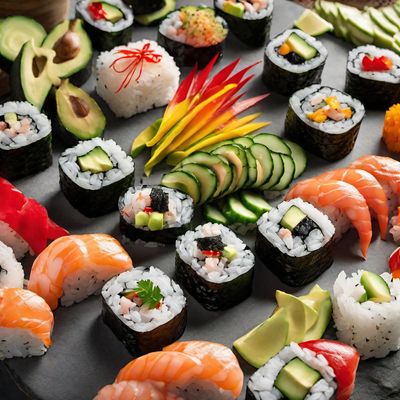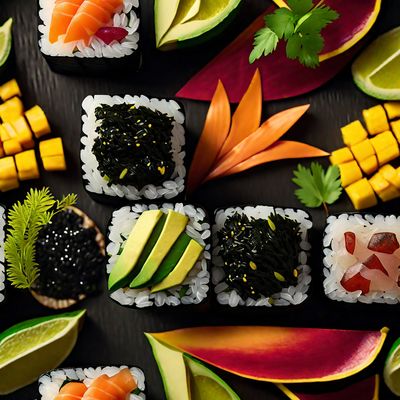
Dish
Sushi
Sushi is a healthy and delicious dish that can be customized to suit individual tastes. The rice used in sushi is typically short-grain white rice that is seasoned with vinegar, sugar, and salt. The filling can be made with a variety of seafood, such as tuna, salmon, or shrimp, as well as vegetables like cucumber, avocado, or carrot. Sushi can be served as individual pieces or as a roll, and is often accompanied by soy sauce, wasabi, and pickled ginger.
Origins and history
Sushi originated in Japan in the 8th century and was originally a way to preserve fish by wrapping it in fermented rice. Over time, sushi evolved into the dish we know today, with the addition of vinegar to the rice and the use of fresh fish. Sushi became popular in the United States in the 1960s and has since spread around the world.
Dietary considerations
Sushi is a good source of protein and carbohydrates, but can be high in sodium and calories depending on the ingredients used. It is not suitable for those with seafood allergies or who follow a vegan or vegetarian diet.
Variations
There are many variations of sushi, including nigiri (sliced fish on top of rice), maki (rolled sushi), and temaki (hand-rolled sushi). Sushi can also be made with brown rice or quinoa instead of white rice, and can be filled with cooked or raw ingredients.
Presentation and garnishing
Sushi is often presented on a platter with pickled ginger and wasabi. It can be garnished with sesame seeds, scallions, or tobiko (flying fish roe).
Tips & Tricks
To make sushi at home, use fresh ingredients and a sharp knife to slice the fish. Wet your hands before handling the rice to prevent it from sticking, and use a bamboo mat to roll the sushi tightly.
Side-dishes
Miso soup, edamame, and seaweed salad are common side dishes served with sushi.
Drink pairings
Green tea, sake, and beer are popular drink pairings for sushi.
Delicious Sushi recipes Browse all »

Turkish-style Sushi Rolls
Bosphorus Bites: Turkish-inspired Sushi Rolls

French-inspired Sushi Rolls
Sushi à la Française

Brazilian-style Sushi Rolls
Tropical Fusion Sushi Delight

Taiwanese-style Sushi Rolls
Taiwanese Fusion Sushi: A Delicious Twist on a Classic

Latin American Sushi Rolls
Samba Sushi: A Fusion of Japanese and Latin American Flavors

Caribbean-inspired Sushi Rolls
Tropical Paradise Sushi Rolls

Croatian-style Sushi
Adriatic Roll

Hungarian-style Sushi Rolls
Paprika Sushi Rolls

Dutch-Style Sushi
Tulip Rolls: A Dutch Twist on Sushi

Arab-style Sushi Rolls
Middle Eastern Fusion: Arab-inspired Sushi Rolls
More dishes from this category... Browse all »

Aji nigiri sushi
Japanese cuisine

Akami nigiri sushi
Japanese cuisine

Anago nigiri sushi
Japanese cuisine

Arroz a la plancha
Spanish cuisine

Arroz a la tumbada
Mexican cuisine

Arroz al forn
Spanish cuisine

Arroz al jerez
Spanish cuisine

Arroz al olivar
Spanish cuisine


